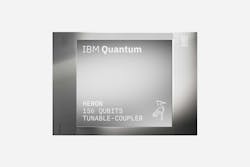IBM envisions classical and quantum computing ‘blend’ for quantum-centric supercomputing
Can you introduce us to IBM Heron/Qiskit and explain why it’s a step forward for the quantum realm?
Blake Johnson: IBM Quantum Heron is our most performant processor to-date. As announced at the IBM Quantum Developer Conference, Heron is now capable of executing certain quantum circuits of up to 5,000 gate operations—nearly twice the number of gates accurately run in the IBM’s 2023 demonstration of quantum utility published in Nature. And, with improvements to our Qiskit software, it can also run the 2023 utility demonstration 50x faster.
In addition to these performance improvements over the 2023 utility demonstration, IBM Heron offers up to a 16-fold overall improvement in performance and 50-fold increase in speed over previous IBM quantum computers as they were measured two years ago.
This Heron processor is now available to our clients, and installed in systems at our data centers in Poughkeepsie, New York, and Ehningen, Germany, IBM’s first quantum data center in Europe.
Qiskit, the world’s most popular quantum software platform, is purposely built to extract the best performance from real quantum hardware as industries across the globe build and discover new quantum algorithms in the search for quantum advantage: the point at which a quantum computer offers the best way to solve a problem over any classical method.
As we extend the reach of reliable execution to larger and larger quantum circuits, we increase the scope of applicability of quantum computing to a broader set of problems. This is a critical prerequisite technology to enabling application and algorithm development in search of quantum advantage.
Can you explain why hitting 5,000 gates is a milestone? What does it mean for security?
Johnson: The combined improvements across IBM Heron and Qiskit extend our users’ ability to reliably execute certain quantum circuits of up to 5,000 gates, which is nearly twice the number of gates accurately run in IBM’s 2023 demonstration of quantum utility. The Qiskit stack now includes a third-generation runtime that enables executing the 2023 utility experiment up to 50x faster, reducing the time to execute it from 112 hours to 2.2 hours.
Our clients and partners are already exploring—and delivering—on capabilities operating at a similar scale. For example, Algorithmiq’s tensor error network mitigation (TEM) method, which is available through the IBM Qiskit Functions Catalog, offers state-of-the-art error mitigation for circuits at utility scale and is capable of supporting circuits with up to 5,000 entangled quantum gates.
Achieving 5,000 gate operations builds on what the broader quantum community has already published with utility-scale experiments. And other Qiskit Functions providers, like Algorithmiq, that have delivered their own capabilities will be able to push the accuracy and scale of quantum circuits to drive algorithm discovery further.
Regarding security, IBM also has the goal of making the world quantum-safe. As our users progress toward advantage, we are also advancing toward potentially cryptographically relevant quantum computers, which could crack today’s encryption in the future. The good news is today’s quantum computers are not cryptographically relevant, but we need to start preparing now. And quantum-safe cryptography exists today—including two IBM-developed PQC algorithms NIST recently published as its first three algorithms as official post-quantum cryptographic standards.
How does Qiskit help quantum developers/researchers?
Johnson: IBM developed Qiskit into the world’s most performant quantum software to enable quantum developers and researchers to more easily create complex quantum circuits with enhanced stability, accuracy, and speed. Qiskit equips more than 600,000 users and more than 250 members of the IBM Quantum Network with the capabilities needed to discover the next generation of quantum algorithms, which will be the crux of their discovery of quantum advantage.
And the Qiskit Functions Catalog is available to IBM Quantum Premium Plan users as services that allow those users to abstract away parts of the quantum software development workflow, which we believe will speed up algorithm and application development.
Biggest challenges involved in connecting quantum and classical supercomputers?
Johnson: To build the next generation of algorithms, users need a toolset to map their problems in a way that leverages both advanced classical and quantum computation, optimizes the problem for efficient execution with quantum, and then effectively executes the quantum circuits on real quantum hardware.
As IBM continues to build milestones along its IBM Quantum Roadmap toward error-corrected systems, Qiskit will continue to deliver a framework for open, iterative, and collaborative development of new quantum algorithms and applications—in conjunction with a growing global ecosystem of clients across industries and domain expertise areas.
These advancing capabilities aim to help users weave together classical and quantum computing resources into a new paradigm of high-performance computing defined by quantum-centric supercomputing that combines quantum processing units (QPUs), graphics processing unit (GPUs), and central processing units (CPUs).
Orchestrated through the performant software layer of Qiskit, this next evolution of high-performance computing aims to open new, large, and powerful spaces for industries globally.
We also announced at our IBM Quantum Developer Conference that Rensselaer Polytechnic Institute (RPI) is using Qiskit tools to take the initial steps to build IBM’s first realization of quantum-centric supercomputing on a university campus. RPI and IBM aim to successfully connect workloads across the AiMOS classical supercomputer and IBM Quantum System One, both located on RPI’s campus, into a single computational environment managed by a standard high-performance computing resource manager.
Power requirements to run Heron/Qiskit?
Johnson: Quantum computer power consumption comes down to the cryostat, control electronics, and runtime on classical servers. Power usage for a quantum computer must be compared to the power usage for a similar workload on a classical computer. In general, quantum computers are expected to consume significantly less power in the future because significantly less time is required to run the workload (a utility scale or future quantum advantage workload).
What’s next?
Johnson: IBM’s Quantum Development Roadmap aims to realize error-corrected quantum computers at scale while continuously advancing the near-term scientific value of today’s systems. This will progress us further into the era of quantum utility and quantum algorithm discovery, and into the era of quantum-centric supercomputing.
IBM’s vision of quantum-centric supercomputing will enable both paradigms of computing—classical and quantum—to work seamlessly together with performant software to solve different parts of complex computing problems that are best suited for their respective strengths and capabilities.

